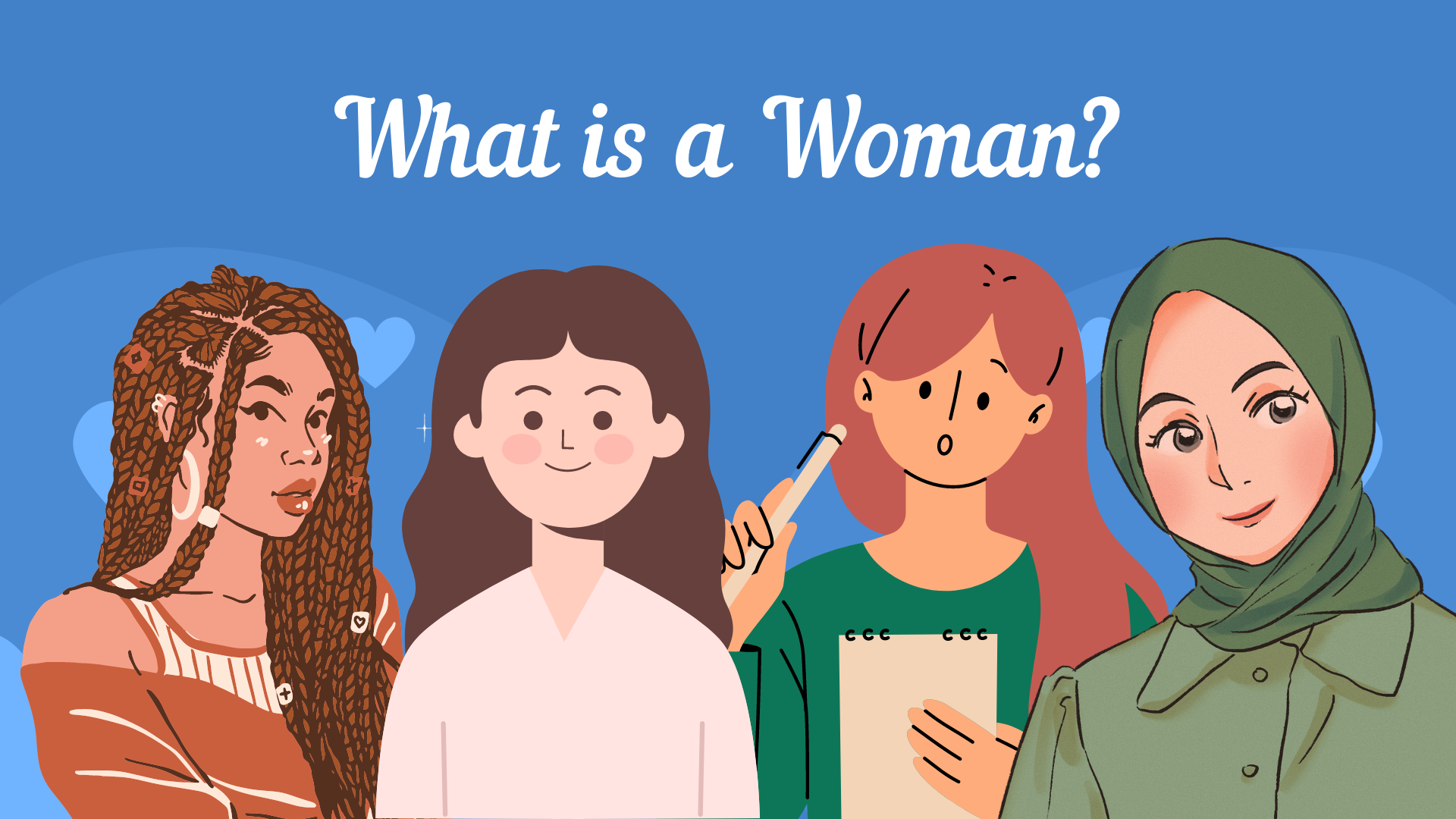It is 2023 and we are questioning “What is a woman?” - I never in my life thought, being a woman myself, why are we questioning this? And the frustrating thing is- Corporations, who do not care if you are LGTBQ+ or a woman, they only care what sells and are erasing what being a woman is. Do we forget how much women have gone though just to have a voice? Equal pay in jobs?
The reason why we are questioning this is because back in 2022 (last year)- that is when this controversy came up "What is a woman?" With the rise of the “trans women are women” mantra, many people seem to be in doubt "what is a woman?"
In March of 2022, U.S. Supreme Court nominee Ketanji Brown Jackson refused to define a woman when asked. Her response: “I’m not a biologist.” Does that presume only biologists know the answer? Many educated scientists squirm when pressed to define a woman because if their answer is “an adult human female,” that disqualifies biological men who “identify” as women. Being politically incorrect, that answer would jeopardize their reputation and possibly end their careers.
Numerous definitions for “woman” have surfaced over the last few years. And now in 2023, the answer "what is a woman" I can say, has fallen into one of three categories: They’re either circular, absurd, or accurate.
First, some definitions of a woman are circular. This mistake occurs when someone attempts to define a word but then uses the word they’re trying to define in the definition. For example, defining nuclear power as “energy derived from a nuclear source” is circular because the word you’re trying to explain, “nuclear,” is used in the definition. Transgender advocates often make the same mistake when they define a woman. They claim, “A woman is anyone who identifies as a woman.” That definition is circular. After all, what is that thing—a “woman”—that the person is identifying as? They need to avoid the term “woman” in their definition if they want to provide a meaningful explanation.
Second, some definitions of a woman are absurd. Cambridge Dictionary has recently amended its definition of a woman: “An adult who lives and identifies as female though they may have been said to have a different sex at birth.” Notice they’ve replaced “woman” with “female.” Though this averts a circular definition, it creates a new problem. “Female” is a reference to biology—a person who has XX chromosomes and reproductive organs that make bearing children possible. What does it mean for a man, who has XY chromosomes, to identify as a person who possesses ovaries, a uterus, and breasts when he doesn’t? It’s absurd.
This is similar to when 69-year-old Dutch TV personality Emile Ratelband decided to identify as a 49-year-old and demanded the courts change his legal age. It’s absurd. No amount of sincerity, hormones, or surgical intervention can make him younger. He can make cosmetic changes to his body that make him look younger, but he’ll never become younger. That’s because age is a biological reality that can’t be changed. In the same way, a person’s sex is a biological reality that can’t be changed. A man can make cosmetic changes to his body to make him look like a woman, but he’ll never become a woman.
The other problem with Cambridge’s 'new definition' is that a woman can now be someone who had a “different sex at birth.” What sex might that be? Male. That means a woman can now be defined as someone who was the opposite of a woman—a man. (cue in the mansplaining- even if a man is identifying as a woman, he is still, biologically a man. Thus, now man is doing what women have hated for centuries - mansplaining. How did we go backwards? And FYI, trans people are loved, always have been. It is the few ones out there who, we don't know about, that have a difference of opinion- for the most part, Trans people are accepted) This is absurd because it makes the word “woman” meaningless when someone who is the opposite sex can be a woman. It’s like saying parallel can be defined as perpendicular lines. Such confused definitions reduce the meaning of words to absurdity.
Some definitions of a woman are accurate. For many years (actually we can say -centuries) defining a woman was uncontroversial. People accepted the dictionary definition: an adult human female. They recognized that women have XX chromosomes, while men have XY chromosomes. Though this definition is accurate, it has some liabilities.
Advocates of transgender ideology point out that not every person can be clearly classified as male or female. Not everyone is born with either XX or XY chromosomes. Some people are born intersex, a term that refers to people born with atypical genetic or biological sex characteristics. For example, some males are born with XXY chromosomes (called Klinefelter syndrome), some females are born with only one X chromosome (called Turner syndrome), some women over- or under-produce sex-related hormones, while others might be born without a vagina (vaginal agenesis). Because these variations exist, it’s argued, being female can’t be as simple as having XX chromosomes or possessing organs like a uterus and ovaries.
People born with atypical genetics or biology represent variations within the sexual binary categories of male and female. Yes, when some people are born, it’s not immediately obvious whether they are male or female. According to a National Institutes of Health study, 1 in 2000 to 1 in 4500 births is a child born with ambiguous genitalia. That’s a very small number. In other words, the vast majority of babies are born obviously male or female. In the rare conditions where it’s unclear at birth, a child’s sex can be discovered with genetic testing, ultrasound, and other evaluative tools.
Although intersex individuals don’t null and void the sexual binary, it’s important to formulate a definition of “woman” that can capture the wide range of variations present in women. Here’s a definition I formulated: A woman is an adult human whose body is organized around two related functions: 1) the production, storage, and delivery of eggs and 2) the gestation of another human being. A man, in a similar way, is an adult human whose body is organized around the production, storage, and delivery of sperm.
Yes, a woman might have atypical genetics or sexual anatomy, but that doesn’t null & voice her categorization as a woman. Even if one or more of her sex organs is missing or has been removed (e.g., mastectomy, hysterectomy), her body is still organized around the use of eggs and the gestation of another human being.
This definition has the additional benefit of clarifying the answer to another question: How do we know there are only two sexes? There are some transgender advocates have voiced that since intersex individuals exist (e.g., not everyone is either XX or XY), there are more than two sexes or sex is on a spectrum. This, however, is pseudoscience. We know there are only two sexes because there are only two kinds of gametes (reproductive cells) that a human can produce. Either your body creates sperm, or it creates eggs. There’s no other possible gamete that a human body can produce. If there were a third gamete, then we could say there is a third sex. There isn’t, however, and that’s why we know there are only two sexes.
Some people can’t produce sperm or eggs (either because they’re intersex or they’ve had the relevant organs removed), but this does nothing to nullify our understanding that there are only two sexes. It just means they’re born with or have had a change to their body that prohibits the development of their male or female sex organs. It doesn’t mean they represent another sex. Think of it this way. If a person is born without a leg, that wouldn’t declassify humans as bipedal (walking on two legs). It just means that an individual person was born with an anomaly—one leg instead of two.
There’s one other objection I’d like to address. Some people reject my definition of a woman because they claim it reduces a woman down to her “breeding parts.” This criticism fails to understand that the definition isn’t intended to define everything about a woman. It’s only intended to define what a mere woman is. It provides the essential characteristics that differentiate a woman from a man. Of course, every woman is more than just an adult human female whose body is organized around breeding. Every woman has her own personality, talents, and relationships. She is unique among the four billion other women on our planet.
It’s rather amazing that the definition of a woman is debated today. It wasn’t long ago that no one asked this question. It’s not because no one knew the answer—virtually everyone did. Rather, no one contested the answer. We live in a different world now. People give less authority to external reality and more authority to inner thoughts and feelings. That’s why a woman can now be a man who “identifies as a woman.” That such a definition can be accepted by a large swath of the population signals that our culture is in complete identity chaos.
Though our culture is confused, we don’t have to be in doubt. What is a woman? I am a woman. I was born biologically a woman and I have a voice. That is what a women, or as my poem states:




















